UNTOEING THE LINE
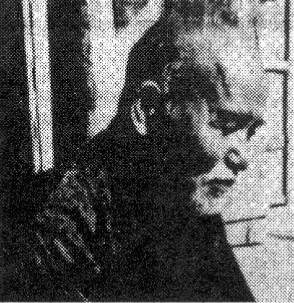
Monks from the banned Unified Buddhist Church of Vietnam (UBCV) are facing more arrests and detention. According to Reuters, a UBCV monk, Thich Khong Tanh, 56, was detained in September. Upon his release he told the UBCV’s Thich Quang Do, the 72-year-old and a one-time Nobel Peace Prize nominee who heads the UBCV’s Institute for the Propagation of the Dharma, that police had warned him about future arrests. Do said, “(The police) disclosed there is already an order to arrest all of us.”
Tanh had been arrested and detained, and documents he was carrying about a recent Buddhist Congress held in Australia were confiscated. UBCV’s Paris-based information service, the International Buddhist Information Bureau, said that Tanh had been accused of “belonging to an ‘illegal organization,’ ‘attempting to turn Vietnam into a new Kosovo’ and “conniving with foreign powers to overthrow the regime.’”
Tanh, Do, and Thich Tue Sy, the UBCV’s secretary-general who was also detained earlier, have a long history of opposition to the Communist government and have spent many years in jail or under detention.
Not letting up their resistance, a few weeks later the UBCV applied to publish a magazine. Do told Reuters that its purpose was “to correct what he said were distortions of Buddhism in official Communist-controlled media.” Do, who has spent most of the last 20 years in detention or jail, said he doubted that they would be given permission. In Vietnam, private publishing is not allowed.
The UBCV was created in former South Vietnam during the Vietnam War. When the war ended in 1975, Hanoi’s Communist rulers seized UBCV property, forcing monks to work or join the army. In 1981, the government created the state-sanctioned Vietnam Buddhist Church, effectively outlawing the UBCV. Hanoi rejects charges of limiting religious freedom.
Image: Venerable Thich Quange Do. Photo courtesy of Free Vietnam Alliance Website.
FALUN GONE?
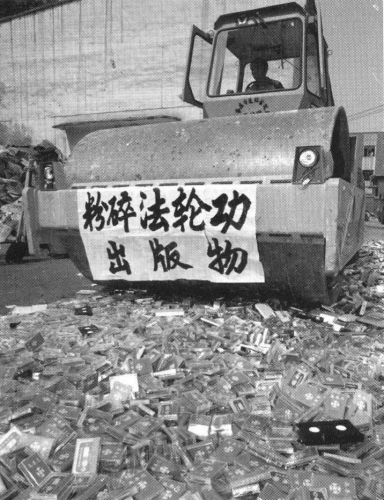
In late April thousands of members of the Falun Gong or Buddhist Law meditation group held Beijing’s largest public gathering since the student protests at Tiananmen Square ten years earlier. The Chinese government responded by banning the group from gathering or practicing, and confiscating and destroying its literature. Thousands of Falun Gong followers have been rounded up for “re-education,” according to the Associated Press, which also reports that estimates of the group’s membership by the Chinese government have fluctuated between 2 million and 70 million.
Falun Gong members practice a combination of meditation and exercise flavored with Taoist and Buddhist teachings. The group’s founder, Li Hongzhi, lives in New York. Spokesmen for the group emphasize that the group has no political agenda and merely promotes health and morality.
The Chinese newspaper,People’s Daily, warned in a commentary in early September that Falun Gong was trying to go underground and must be completely stopped by punishing its remaining leaders. The commentary called for “maintaining a high level of vigilance,” because “we cannot expect one storm to sweep away all the garbage.”
Image: Government bulldozers destroy Falun Gong books and videotapes. Photo courtesy of AP WorldWide Photos.
GREAT STUPA FOR PEACE: A REPORT FROM TIBET
Over 1,200 years ago Padmasambhava prophesized that a giant Stupa would be built in the area of Golok, Tibet. Padmasambhava, known as “the Lotus-born,” introduced Buddhism to Tibet from India in the eighth century. Over time many other lamas repeated this same prophecy. As a very young boy His Holiness Orgyen Kusum Lingpa had a series of dreams in which Padmasambhava, as well as the deities, Varjapani and Hayagriva, instructed him to build just such a Stupa. So at the age of twenty Kusum Lingpa made a commitment to his teacher, Akong Khenpo Rinpoche, that he would realize Padmasambhava’s prophecy.
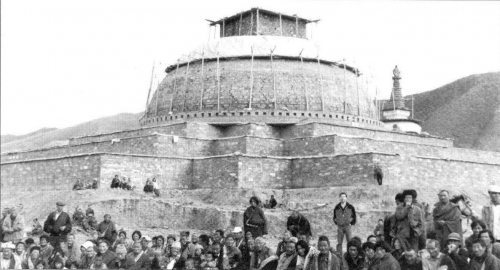
When the Great Stupa for Peace was completed at Thupten Chokor Ling Monastery, many of Kusum Lingpa’s 100,000 students from around the world made a pilgrimage to Tibet for the dedication ceremony.
The Great Stupa for Peace houses an impressive collection of relics including: 1,008 sets of complete Buddhist teachings, 100 million pictures of Padmasambhava, 10 million sets of dharani (mantras), statues, and, reportedly, relics of the historical Buddha and of Padmasambhava.
Larger than the Great Stupa of Bodanath, it has a base of 69 meters and a height of 50 meters. More than five years of planning went into the project. Extensive engineering studies required nearly 200 workers two years to complete the stupa’s construction. The structure is dedicated solely for the purpose of alleviating famine, plague, warfare, and all other suffering in the world today. Recently His Holiness said, “This is a pivotal time when our compassion and the existence of the Great Stupa For Peace can inspire millions towards sanity and away from catastrophe.”
– Lama Chuck Stanford
Image: Great Stupa for Peace, Golok, Tibet. Photo courtesy of Lama Chuck Stanford.
SWEET SURRENDER
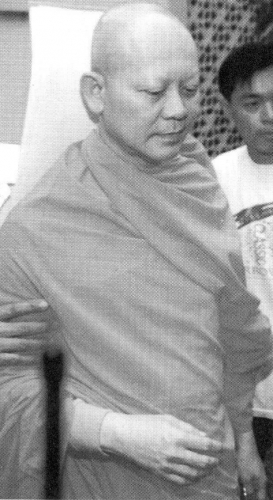
The controversial Thai abbot, Phra Dhammachayo, besieged by protests and investigations over the summer—most notably, by charges that he embezzled millions of dollars—gave himself up to the police in late August and ended a two-day stand-off between his followers and the local police. At least 20,000 of his followers had gathered outside his temple to try to prevent his arrest.
Phra Dhammachayo was the charismatic abbot of the Wat Dhammakaya temple on the outskirts of Bangkok, which had been built for an estimated $43 million dollars. Various marketing programs at the Wat, such as a “millionaire forever” program through which donors could buy Buddha images or a guarantee of wealth in the next life, had the religious community in Thailand in a furor. A ceremony to defrock Phra Dhammachayo was attended by 5,000 monks.
The former abbot surrendered to authorities ahead of a deadline set by police, and he was later released on bail set at two million baht ($53,000). According to the BBC, at the height of his following, the former abbot counted as many as 100,000 followers. Official reports show that approximately $100 million from followers had been donated to his temple, which has branches in Japan and the United States.
This is the latest in a series of scandals, including illicit sex and gambling, surrounding Thai monks, all of which have damaged the reputation of the Buddhist priesthood in a country where more than 90 percent of its population of 61 million is Buddhist.
Image: Phra Dhammachayo. Photo courtesy of AP WorldWide Photos.
DHARMA BITES
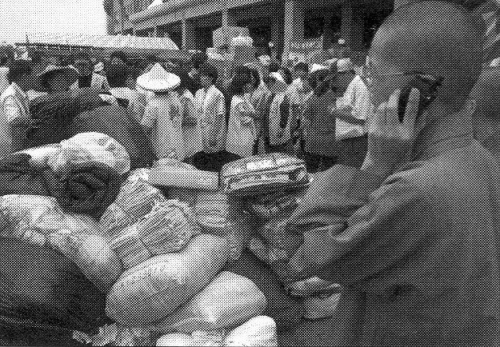
- Following Taiwan’s earthquake in September, the Tzu Chi Buddhist Relief Foundation, Taiwan’s largest Buddhist charity, delivered vital medical aid, food, and temporary shelters to remote mountain villages. Also, Soka Gakkai International (SGI) contributed close to $100,000 in emergency assistance funds.
- In New York, the spiritual life of women was celebrated when eleven nuns of the Khachoe Ghakyil Nunnery performed for the first time outside of Tibet. The program at the American Museum of Natural History included sacred dances as well as an original dance dramatizing the life of the Tibetan saint, Milarepa.
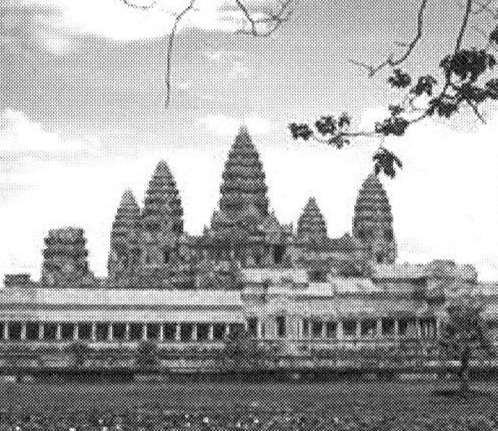 Angkor Wat and its outlying temples are now Cambodia’s top tourist attraction. But looting of temples continues. At a ceremony celebrating restoration work of the Bayon section of Angkor Wat, Queen Monineath Shihanouk recently pleaded for the protection of temples through government and international action.
Angkor Wat and its outlying temples are now Cambodia’s top tourist attraction. But looting of temples continues. At a ceremony celebrating restoration work of the Bayon section of Angkor Wat, Queen Monineath Shihanouk recently pleaded for the protection of temples through government and international action.- Is the government of Burma forcing Buddhism on its Christian minorities? The U.S. State Department says so. In its Annual Report on International Religious Freedom, the State Department alleges that Burmese security forces forced the conversion of many Christians and sought to prevent them from proselytizing by “highly coercive means” including “religiously selective exemptions from forced labor, and by arresting, detaining, interrogating, and physically abusing Christian clergy.”
- Burgundy, the color of Tibetan monks’ robes is on the fashion front. Migmar Tsering, a 22-year-old Tibetan who was raised in India and educated in England, was due to unveil his Free Tibet clothing collection in the U.S. last fall. According to Mr. Tsering, ten percent of sales will benefit the Free Tibet campaign.
- One of the world’s largest centers for the study of Tibetan Buddhism has arisen in the remote Sichuan Province of China. Established in 1980 by Khenpo Jikphun, the monastic center Serthar has attracted some 8,000 monks and nuns to date, including both Tibetans and ethnic Chinese. According to the New York Times, construction of Serthar was funded largely by private donations from the Tibetan community.
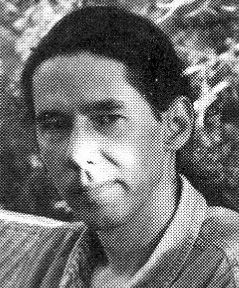 Name Dropping: Naropa grad and long-time Zen student, Sean Murphy, has been awarded the 1999 Hemingway Award for his novel The Hope Valley Hubcap King. + The Dalai Lama recently announced that he will not be reincarnated in occupied Tibet, but in a free country outside of Chinese control.+ In Japan, the Buddhist establishment is under fire for its name game program. “Good afterlife names” can be bought for as much as $8,300 by the devout who think a name can help the deceased find an agreeable future.+ Rupert Murdoch, with a gazillion in broadcasting profits and a new Chinese wife, has turned his sights on the Dalai Lama. In a recent interview with William Shawcross in Vanity Fair, Murdoch claimed that the Tibetans are better off with the Chinese takeover (“people are more prosperous”) and that the Dalai Lama is a big part of the Tibetans’ problems: “ . . . half the people of Tibet still think the Dalai Lama is the son of God.” But, he added, “I have heard cynics who say he’s a very political old monk shuffling around in Gucci shoes.”
Name Dropping: Naropa grad and long-time Zen student, Sean Murphy, has been awarded the 1999 Hemingway Award for his novel The Hope Valley Hubcap King. + The Dalai Lama recently announced that he will not be reincarnated in occupied Tibet, but in a free country outside of Chinese control.+ In Japan, the Buddhist establishment is under fire for its name game program. “Good afterlife names” can be bought for as much as $8,300 by the devout who think a name can help the deceased find an agreeable future.+ Rupert Murdoch, with a gazillion in broadcasting profits and a new Chinese wife, has turned his sights on the Dalai Lama. In a recent interview with William Shawcross in Vanity Fair, Murdoch claimed that the Tibetans are better off with the Chinese takeover (“people are more prosperous”) and that the Dalai Lama is a big part of the Tibetans’ problems: “ . . . half the people of Tibet still think the Dalai Lama is the son of God.” But, he added, “I have heard cynics who say he’s a very political old monk shuffling around in Gucci shoes.”
Image 1: A Buddhist monk helps out in Taiwan. Photo courtesy of AP WorldWide Photos.
Image 2: Angkor Wat. Photo courtesy of Rachel Rinaldo.
Image 3: Photo courtesy of Sean Murphy.
SANGHA NEWS
Together A-Zen The annual meeting of the American Zen Teachers’ Association was held at the Rochester Zen Center in August. According to Bodhin Kjolhede, abbot of the center, eighteen teachers representing sanghas across North America participated. The three main presentations were: “The Graying of the Sangha,” “Ethical Misconduct: A Method for Handling and Preventing Crisis in the Sangha”; and “Empowering the Lay Sangha: Ordination/Authorization Practices for Senior Lay Students.” Other topics discussed were requirements and expectations of the western student, and the difficulties of fundraising.
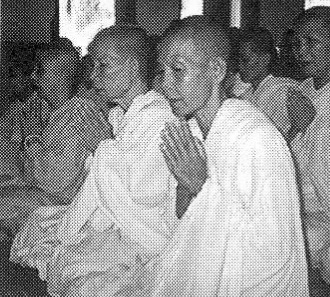
Buddhist Women to Visit Buddha’s Birthplace Sakyadhita (Daughters of the Buddha) will sponsor its Sixth International Conference on Buddhist Women in Lumbini, Nepal from February 1 to 7, 2000. (See article on Lumbini, page 25.) The theme of the conference is “Women as Peace Makers: Self, Family, Community, World.” Sakyadhita’s mission to empower Buddhist women is reflected by the conference’s focus on meditation, workshops, and discussions. Topics include “Understanding Women in Buddhist Cultures,” “Women’s Health in the Buddhist Community,” “Women for a Peaceful Millennium,” and “Paths to Enlightenment—Family and Monastery.” For complete information, contact Sakyadhita by fax in Hawai’i at 808-944-7070; or by email at tsomo@hawaii.edu.
Image: Cambodian and Sri Lankan nuns recite sutras. Photo courtesy of Sakyadhita-The International Association of Buddhist Women.

Aloha Dharma Hawai’i Island (the Big Island) will soon be home to Hawai’i Insight Meditation Center (HIMC). Under the guidance of teachers Steven Smith and Michele McDonald-Smith, the purchase of an 180-acre piece of land on Hapu’u Bay will soon be complete. HIMC will offer a long-term practice hermitage, retreats for all levels of students and specialized retreats for young adults, families, and environmental, medical, educational, and corporate leaders. Individuals with experience in development, facilities management, and environmental sustainability are needed. Information: himc@vipassanahawaii.org or www.vipassanahawaii.org or write HIMC, 380 Portlock Road, Honolulu, HI 96825.
Image: Photo courtesy of Big Island Vistors Bureau.
Boulder Steps The Boulder Institute and the Spirit in Education Movement of Buddhist human rights advocate Achaan Sulak Sivaraksa sponsor the eighth Interfaith Solidarity Walk next month. The ten-day walk will depart from Chiang Mai, Thailand on December 7. Information: invoke@dimensional.com or write Boulder Institute, 1314 8th St., Boulder, CO 80302.
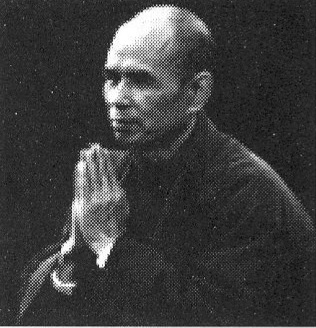
Plum Village Germinates Southern California will be home to a new Plum Village. Thich Nhat Hanh’s Unified Buddhist Church Inc. (UBC) will establish a sister organization to its Plum Village Sangha in France and its Maple Forest Monastery and Green Mountain Dharma Center in Vermont. Plans are to purchase a 436-acre parcel of land located 30 miles northeast of San Diego and 100 miles south of Los Angeles, with construction slated for early 2000. Information: www.plumvillage.org.
Image: Thich Nhat Hanh. Photo courtesy of Mindfulness Community in Israel.
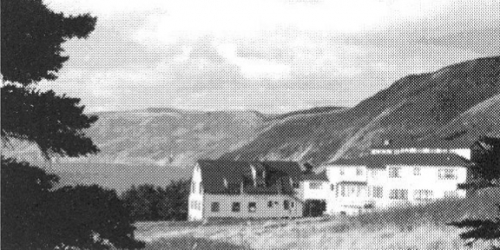
Gampo Adds a Year After three years of planning, the monastic college at Gampo Abbey in Nova Scotia launched its first formal, one-year course of study in September, which includes temporary ordination. While temporary ordination is common for other traditions, it is experimental within the Vajrayana community. The program includes intensive Tibetan language study, and kyudo and tai chi are offered in required mind/body disciplines. The college offers a traditional monastic setting and a thorough educational program in the Vajrayana tradition. Opening day celebrations featured remarks from the college’s principal teacher, Gelong Lodro Sangpo.
Image: Gampo Abbey. Photo courtesy of Gampo Abbey.
IN MEMORIAM
- Dzogchen master Nyoshul Khenpo Rinpoche died on August 27th at Antamnies in Dordogne, France. One of the most eminent contemporary Tibetan Buddhist teachers and a lineage holder of the Longchen Nyinthig (“Heart Essence”) Dzogchen tradition, Khenpo Rinpoche was bom in eastern Tibet in 1932. After fleeing to India in 1959, he became a close disciple of the late Dudjom Rinpoche and the late Dilgo Khyentse Rinpoche. A poet and an honored scholar, Khenpo Rinpoche was perhaps best known in the United States for his tutelage of several prominent American Buddhists, Lama Surya Das, Sharon Salzberg, and Joseph Goldstem.
- Marilyn Silverstone, a well-known news photographer who left her career to become a Buddhist nun 22 years ago, died of cancer on September 28th in Kathmandu. Silverstone had worked for the New York Times, Life, Newsweek, and the London Sunday Times. Her photographs included the first images of the Dalai Lama’s arrival in India in 1959 and the funeral of India’s first prime minister, Jawharlal Nehru. She left Journallsm abruptly in 1977, moved to Nepal, and became a devoted disciple of the late Dilgo Khyentse Rinpoche. For the remainder of her life, she lived as a Buddhist nun at Shechen Monastery in Kathmandu. She received full ordination in a ceremony in Hong Kong in 1987.
- Nikkyo Niwano, winner of the 1979 Templeton Foundation Prize for Progress in Religion and founder of Rissho Kosei-kai (RKK), a lay Buddhist organization with over six million members worldwide, died on October 4th. A pioneer for interreligious cooperation, Niwano’s books include The Meaningful Life, Shakyamuni Buddha, The Wholesome Family Life, and The Richer Life.
Thank you for subscribing to Tricycle! As a nonprofit, we depend on readers like you to keep Buddhist teachings and practices widely available.